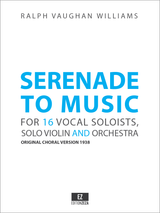
Five Tudor Portraits (1935), by Ralph Vaughan Williams, is a work scored for contralto (or mezzo-soprano), baritone, mixed chorus and orchestra. It sets several poems, or extracts from poems, by the 15th/16th-century poet John Skelton, portraying five characters with a mixture of satire, compassion, acerbity and earthy humor. Though acclaimed by critics, it has not been so frequently performed as some of Vaughan Williams' other works. In its complete form it lasts about 42 minutes, though the composer also sanctioned the performance of individual movements separately.
Five Tudor Portraits owes its origin to a conversation with Sir Edward Elgar, who suggested that Vaughan Williams set Elinor Rumming; Skelton's metre, he said, was often pure jazz. Vaughan Williams selected and began to set texts from Philip Henderson's edition of Skelton's poems for six portraits, eventually rejecting one, Margery Wentworth. The poems were treated with much freedom, the composer cutting them down radically (less than one third of Elinor Rumming and Philip Sparrow were used) and sometimes even rearranging the order of the lines. By 20 June 1935 he had "rough-finished" the work.
The five movements are:
- Ballad: The Tunning of Elinor Rumming. Allegro pesante. Contralto solo, mixed chorus and orchestra. Poem: The Tunning of Elinour Rumming.
- Intermezzo: Pretty Bess. Allegretto grazioso. Baritone solo, mixed chorus and orchestra. Poem: Speak, Parrot.
- Burlesca: Epitaph on John Jayberd of Diss. Allegro. Male chorus and orchestra. Poem: A Devout Trental for Old John Clarke, Sometime the Holy Patriarch of Diss.
- Romanza: Jane Scroop (Her Lament for Philip Sparrow). Lento doloroso. Mezzo-soprano (or contralto) solo, female chorus and orchestra. Poem: Philip Sparrow.
- Scherzo: Jolly Rutterkin. Allegro moderato. Baritone, mixed chorus and orchestra. Poems: Jolly Rutterkin and Magnificence
The vocal forces used in this work are contralto or mezzo-soprano, baritone, and mixed chorus.[24] The instrumentation is: 3 flutes (3rd doubling piccolo), 2 oboes, 1 cor anglais, 2 clarinets, 2 bassoons, 1 double bassoon, 4 French horns, 2 trumpets, 3 trombones, 1 tuba, timpani (chromatic ad lib.), percussion (2 players), harp and strings. Vaughan Williams sanctioned a degree of flexibility, the following instruments being dispensable at need: flute 2, oboe 2, double bassoon, French horns 3 and 4, tuba, percussion 2. He instructed that if a harp were unobtainable a piano should substitute for it.
- Difficulty:
- Intermediate/Advanced
- Instrumentation:
- 3Fl1dPicc, 2Ob1dCA, 2Cl, 2Bsn, Cbsn, 4Hn, 2Tpt, 3Tbn, Tba, Timp, Perc(2),Hp, Strings. Vocal: Contralto or Mezzo, Baritone, Mixed Chorus SATB
- Duration:
- ca 45 minutes
- Set of Parts:
- Includes Strings count 4.4.3.3.2
- Extra Strings / Vocal Score:
- Only available with the purchase of the Set of Parts






